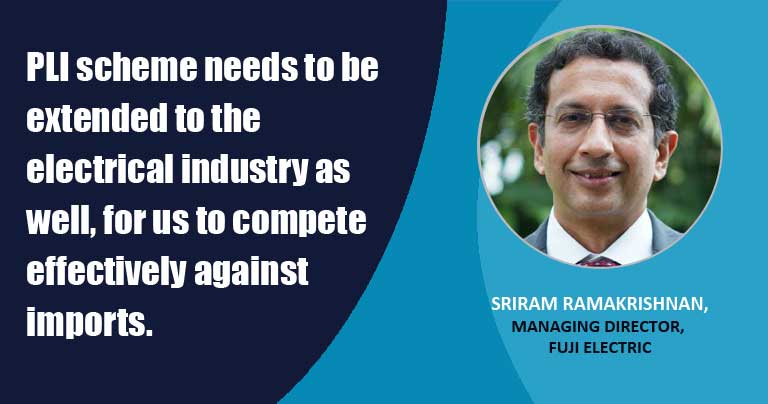Exploring potential of India’s manufacturing capabilities
By EPR Magazine Editorial November 9, 2021 10:44 am IST
By EPR Magazine Editorial November 9, 2021 10:44 am IST

Discussing trends in the electrical equipment sector, Sriram Ramakrishnan, Managing Director, Fuji Electric highlights the benefits, challenges, and expectations from the government to augment’s localisation in India.
How are the energy trends impacting the electrical equipment and accessories market?
Energy efficiency is a major trend which is re-shaping the electrical equipment industry. Customers are looking at the total cost of ownership, which includes both capital cost efficiency and lower operational costs based on higher energy efficiency. In addition, many of our customers are increasingly opting for sustainable and green infrastructure. Fuji Electric is a pioneer in innovating energy technology and our core DNA is to address and solve today’s and upcoming challenges to propel our customers into an efficient and scalable future by providing the highest-quality energy and automation solutions.
Fuji Electric products leverage the latest in power semiconductor technology like IGBT, designed and manufactured by Fuji Electric in many of its power electronic platforms, like energy-efficient UPS and variable frequency drives. Fuji Electric is also a pioneer in renewable energy solutions with comprehensive offerings of Solar Inverters, Fuel Cells and Geo-Thermal Power Plants.
How do you view the demand and application for AI, automation and digitisation for efficient distribution in the power sector?
The power sector is one of the many that are experiencing deep and lasting changes to business models and operations due to AI, automation, and digitisation.
We have seen a lot of transformation in this sector, and the industry does not look like it was a few decades ago. A Smart Grid is the norm today, especially with the increasing amounts of highly variable renewable power being connected to the grid. The implementation of AI, data automation, predictive analysis, and machine learning (ML) is in the early stages of adoption, but awareness is growing.
Smart metres will become essential for all consumers of electricity, and sensors along transmission lines will be able to constantly monitor demand and supply to ensure stability of the electrical grid. Many industries are opting for AI technology to reduce overall power consumption, which will result in large savings, especially for power-hungry industries like steel, cement, and data centers.
 What are the challenges present in the market, especially in terms of cost and obtaining raw materials?
What are the challenges present in the market, especially in terms of cost and obtaining raw materials?
We are facing an unprecedented global supply chain challenge on a variety of commodities that are impacting availability and costs in the electrical industry. Many of the metals used in electrical equipment, like copper, aluminium, steel, and electrical steel, are now trading at historic highs due to an increase in demand globally post-Covid. In addition, there is a global shortage of semiconductors used to provide intelligence to electrical equipment, leading to extended delivery periods and higher procurement costs. In addition, freight costs have increased multifold due to the limited availability of containers.
The supply chain volatility is expected to continue for another 12-18 months before supply can meet the global demand. In this situation, many suppliers have increased lead times and are also passing on the cost increases to the market.How are the increased imports of electrical equipment and accessories impacting the market players?
After two deadly waves of the COVID-19 pandemic, our economy needs a strong manufacturing push. India has huge untapped potential to become a global manufacturing hub, but growth in manufacturing has been abysmal despite the availability of cost-effective and skilled labor.
The government needs to provide incentives and the infrastructure to level the playing field with other countries. The Production Linked Incentive (PLI) scheme needs to be extended to the electrical industry as well, for us to compete effectively against imports from China and other countries. In addition, the government needs to support the development of a local supply chain eco-system by securing the availability of raw materials and components used by the electrical industry.
 How are government policies helping the industry to increase localisation and domestic manufacturing in this sector?
How are government policies helping the industry to increase localisation and domestic manufacturing in this sector?
The ‘Make in India’ initiative has been in focus and adopted by various industries for some time now. However, as global businesses look to diversify their supply chains, the spotlight is back on the government’s ‘Atmanirbhar Bharat’ (Self-Reliant India) campaign.
Localisation can truly bear fruit when industries and governments come together to keep pushing forward this agenda. Various efforts by the government, such as the Skill India program, the Ease of Doing business policies, Production Linked Incentive scheme (PLI), focus on Foreign Direct Investment, etc. are all steps in the right direction. By combining government and industry efforts, everyone stands to win.
With the global energy sector going green, what kind of efficient equipment can be expected in the coming years?
Climate change is a reality, and the push for carbon neutrality and going green is becoming the urgent need of the hour. The decreasing cost of renewable energy is accelerating the rollout of renewable energy generation power plants, and they are increasingly becoming the major power generation source in many countries. With the expected growth of electric vehicles, electricity is increasingly becoming the most important energy source in many economies, and this is spotlighting the need to reduce energy consumption by increasing the energy efficiency of all electrical equipment.
Today, we see that energy is climbing up the corporate agenda due to sweeping environmental, social, and business trends, including climate change and global carbon regulation, increasing pressures on natural resources, rising expectations about corporate environmental performance, innovations in energy technologies and business models, and plummeting renewable energy prices. This also provides a platform for innovating more and more energy-efficient products for better utilisation of energy. These megatrends impacting the global energy sector change the context in which businesses operate and open companies up to innovation and new paths for value creation in the future.
We use cookies to personalize your experience. By continuing to visit this website you agree to our Terms & Conditions, Privacy Policy and Cookie Policy.